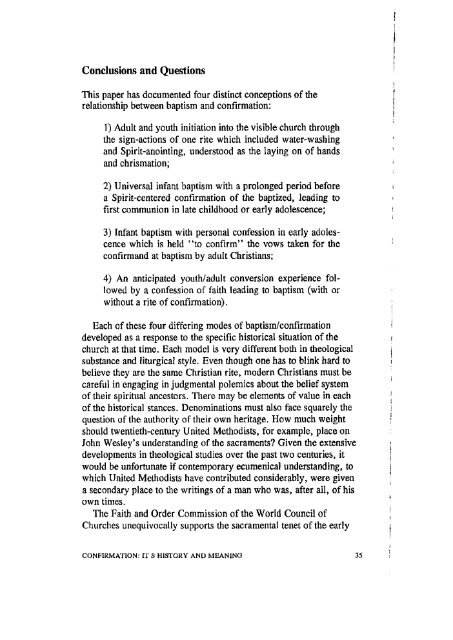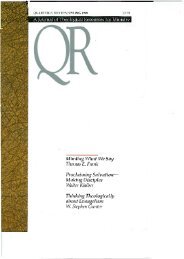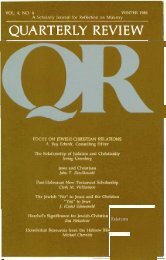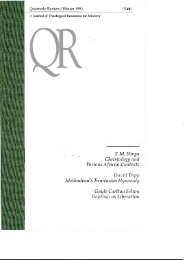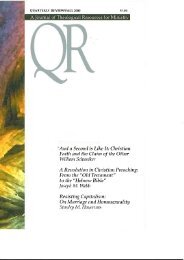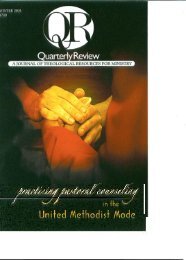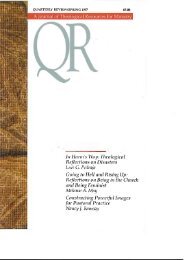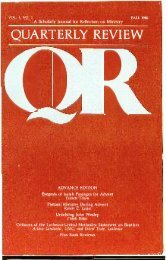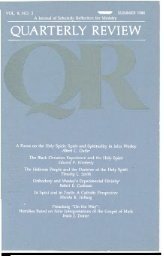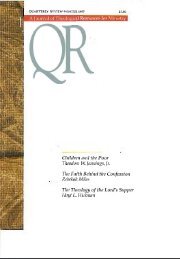TJieodore W. Jennings, Jr. The Meaning of ... - Quarterly Review
TJieodore W. Jennings, Jr. The Meaning of ... - Quarterly Review
TJieodore W. Jennings, Jr. The Meaning of ... - Quarterly Review
You also want an ePaper? Increase the reach of your titles
YUMPU automatically turns print PDFs into web optimized ePapers that Google loves.
Conclusions and Questions<br />
This paper has documented four distinct conceptions <strong>of</strong> the<br />
relationship between baptism and confirmation:<br />
1) Adult and youth initiation into the visible church through<br />
the sign-actions <strong>of</strong> one rite which included water-washing<br />
and Spirit-anointing, understood as the laying on <strong>of</strong> hands<br />
and chrismation;<br />
2) Universal infant baptism with a prolonged period before<br />
a Spirit-centered confirmation <strong>of</strong> the baptized, leading to<br />
first communion in late childhood or early adolescence;<br />
3) Infant baptism with personal confession in early adolescence<br />
which is held "to confirm" the vows taken for the<br />
confirmand at baptism by adult Christians;<br />
4) An anticipated youth/adult conversion experience followed<br />
by a confession <strong>of</strong> faith leading to baptism (with or<br />
without a rite <strong>of</strong> confirmation).<br />
Each <strong>of</strong> these four differing modes <strong>of</strong> baptism/confirmation<br />
developed as a response to the specific historical situation <strong>of</strong> the<br />
church at that time. Each model is very different both in theological<br />
substance and liturgical style. Even though one has to blink hard to<br />
believe they are the same Christian rite, modern Christians must be<br />
careful in engaging in judgmental polemics about the belief system<br />
<strong>of</strong> their spiritual ancestors. <strong>The</strong>re may be elements <strong>of</strong> value in each<br />
<strong>of</strong> the historical stances. Denominations must also face squarely the<br />
question <strong>of</strong> the authority <strong>of</strong> their own heritage. How much weight<br />
should twentieth-century United Methodists, for example, place on<br />
John Wesley's understanding <strong>of</strong> the sacraments? Given the extensive<br />
developments in theological studies over the past two centuries, it<br />
would be unfortunate if contemporary ecumenical understanding, to<br />
which United Methodists have contributed considerably, were given<br />
a secondary place to the writings <strong>of</strong> a man who was, after all, <strong>of</strong> his<br />
own times.<br />
<strong>The</strong> Faith and Order Commission <strong>of</strong> the World Council <strong>of</strong><br />
Churches unequivocally supports the sacramental tenet <strong>of</strong> the early<br />
CONFIRMATION: IT S HISTORY AND MEANING 35


